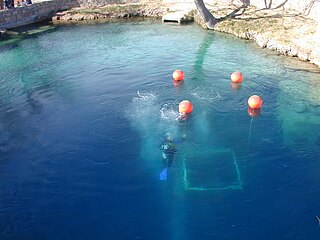
Carl Henry Eigenmann was a German-American ichthyologist of the late nineteenth and early twentieth centuries, who, along with his wife Rosa Smith Eigenmann, and his zoology students is credited with identifying and describing for the first time 195 genera containing nearly 600 species of fishes of North America and South America. Especially notable among his published papers are his studies of the freshwater fishes of South America, the evolution and systematics of South American fishes, and for his analysis of degenerative evolution based on his studies of blind cave fishes found in parts of North America and in Cuba. His most notable works are The American Characidae (1917–1929) and A revision of the South American Nematognathi or cat-fishes (1890), in addition to numerous published papers such as "Cave Vertebrates of North America, a study of degenerative evolution" (1909) and "The fresh-water fishes of Patagonia and an examination of the Archiplata-Archelenis theory" (1909).

Triplophysa is a genus of fish in the family Nemacheilidae found mainly in and around the Qinghai-Tibet Plateau in China, as well as inland waters of the larger part of central Asia. They can be distinguished from other genera of Nemacheilidae by marked sexual dimorphism, including the development of nuptial tubercles on breeding males. Currently, the genus is a mixed assemblage of species. Some lineages have been identified and treated as subgenera, but as Wikipedia follows Fishbase for fish species all but Hedinichthys have been treated as subgenera in Wikipedia, although Kottelat in his revision of the loaches did recognise them as valid. FishBase, however, includes these in Triplophysa without specifying subgenera and treats the names given by Kottelat as synonyms.
Triplophysa xiangxiensis is a species of stone loach endemic to Yuan River in Hunan, China. It is a cave-dwelling species. It grows to 9.9 cm (3.9 in) SL.

The Blue Hole of Santa Rosa, or simply the Blue Hole, is a circular, bell-shaped pool or small lake located along Route 66 east of Santa Rosa, New Mexico that is a tourist attraction and swimming venue, and one of the most popular dive destinations in the US for scuba diving and training. The Blue Hole is an artesian well and cenote that was once used as a fish hatchery.
Triplophysa choprai, the snow loach, is a species of ray-finned fish in the subgenus Indotriplophysa of genus Triplophysa.

Triplophysa intermedia is a species of stone loach in the genus Triplophysa. The species has only been found in Hulun Lake in Inner Mongolia, China; but is believed to appear in other locations as well since fish in this genus are typically found in running water.
Triplophysa ladacensis is a species of ray-finned fish in the genus Triplophysa. It is endemic to deeper parts of rivers in Jammu and Kashmir in India.
Triplophysa longibarbata is a species of ray-finned fish in the genus Triplophysa. This cavefish is only known from Guizhou in China.
Triplophysa longipectoralis is a cave-living species of stone loach with vestigial eyes. The fish lives in clear water at temperatures below 20 °C. The holotype was caught in Xunle town, Huanjiang Maonan Autonomous County in the Liu River basin, Guangxi, China and was described by Zheng et al. in 2009.
Triplophysa minuta is a species of ray-finned fish in the genus Triplophysa.
Triplophysa orientalis is a species of stone loach. It is a freshwater fish from the Tibetan Plateau and is endemic to China; its distribution includes the upper reaches of the Yangtze and Yellow Rivers, among others. It lives in a wide range of habitats, both lentic and lotic. The species is widespread but populations tend to be isolated and show high degree of genetic divergence.

The Tibetan stone loach is a species of ray-finned fish in the family Nemacheilidae. The specific name is sometimes spelled stoliczkae but the original spelling used by Steindachner is stoličkai. It is found in southern and central Asia.
Triplophysa yunnanensis is a species of ray-finned fish in the genus Triplophysa. It is a cave-dwelling species endemic to Yunnan, China. It grows to 6.3 cm (2.5 in) SL.
Triplophysa zhaoi is a species of ray-finned fish in the genus Triplophysa. It grows to 8 cm (3.1 in) SL. It is endemic to China and inhabits swampy creeks.
Claea dabryi is a species of stone loach endemic to the Jinshajiang river basin in China. Commonly known as 戴氏南鰍, which translates as Dai's southern loach.

The Nemacheilidae, or stone loaches, are a family of cypriniform fishes that inhabit stream environments, mostly in Eurasia, with one genus, Afronemacheilus found in Africa. The family includes about 790 species.

Solomon Markovich Herzenstein was a Russian zoologist.
Triplophysa anshuiensis is a species of stone loach in the family Nemacheilidae. It is endemic to Lingyun County in Guangxi, China, where it lives in a karst cave.
Triplophysa dongganensis is a species of stone loach in the genus Triplophysa. It is endemic to Guangxi, China. This species reaches a length of 10.6 cm (4.2 in)
Triplophysa wulongensis is a species of ray-finned fish in the genus Triplophysa endemic to a single subterranean pool in Furong Cave, Wulong County, Chongqing, China.





